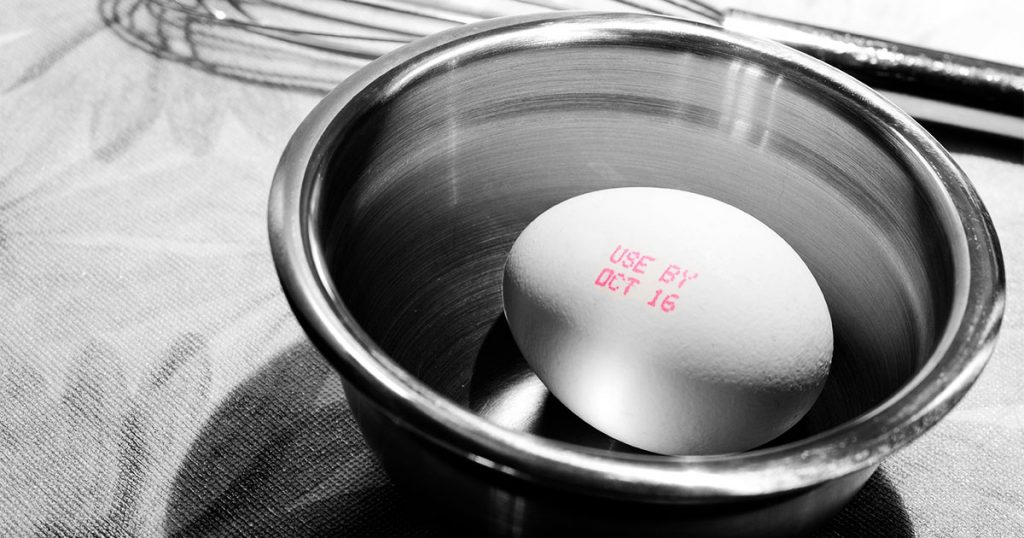I come from a family of food scientists. You might think that because of this we were sticklers for food expiration dates, that we never had a salad dressing or jar of pickles or gallon of milk in the fridge past that printed date on the container. You would be wrong. Because expiration dates don’t mean what you think they mean.
First things first, let’s clear up some oft-misunderstood terminology. Most dates on the bottom of jars or cans are actually use by dates, not expiration dates. These dates aren’t the date when the food turns to toxic poison that’ll leave you spending hours in the bathroom. They’re just recommended dates when the product will taste best. And they’re completely voluntary. That’s right, other than infant formula, food dating isn’t required by the U.S. Food and Drug Administration (FDA).
“[Food item dating] acts exclusively as the maker’s most realistic estimation regarding when its item will presently don’t be at top quality, whatever that implies,” reports The New York Times. “Food producers additionally will in general be fairly traditionalist with those dates, realizing that not we all keep our storage spaces dull and open our fridges as insignificantly as essential.”
So that container of escapades from last year that is as yet sitting toward the rear of your cooler, or that tin of cinnamon you got two Christmases prior? Other than losing a little character, they are absolutely fine to eat.
“We as a whole ridicule our folks for utilizing flavors that lapsed during the 1980s, yet, other than losing power, there’s nothing criminal in utilizing them,” composed J. Kenji López-Alt in The New York Times.
Truth be told, with food uncertainty on the ascent, it’s damn close to criminal to throw completely great food on account of a discretionary date composed outwardly of its bundling.
That said, there are foods that can and do go bad. But in these cases, there’s rarely any confusion about it. Moldy bread with green patches growing on it. Milk that smells like a baby’s diaper. Or cottage cheese with some extra chunks in it…those are all pretty obvious signs to stay away.
So what do those dates on the packaging actually mean?
Well, they mean slightly different things depending on the food and manufacturer, so look carefully. Here are the variations:
– “Sell-By” Date: this tells you how long a store can sell a product. It’s best to buy food before the sell-by date expires, but it’s still safe to eat after this date.
– “Best if Used By” Date: This is pretty obvious – the food will taste best if consumed by this date. It’s all about quality, not safety.
– “Use-By” Date: Similar to the “Best If Used By” Date, this one is about quality.
– Closed Dates: These are numbers that don’t look like a date at all and are actually packing codes used by the manufacturer.
Ignoring Those Dates Might Actually Be a Good Thing.
As per the National Resources Defense Council (NRDC), 40% of the food – or $218 billion worth of food — created in America goes uneaten consistently and disarray about termination dates may assume a major part. Moreover, NRDC reports that “in excess of 80% of Americans misjudge date marks and discarding food rashly, under the misguided judgment that it’s important to secure their families’ wellbeing.”
Food squander isn’t simply harming our own wallets, it’s stinging the whole nation and worldwide local area. Rather than worrying over the dates imprinted on the food bundling, it’s greatly improved to focus on appropriate food taking care of. The USDA even has an application to assist with directing you through food stockpiling and taking care of so your food endures longer, you lessen food waste, and set aside some cash simultaneously.
So What Does This All Mean?
For those of you who have been a stickler for those printed dates, you might be feeling a little panicky right now. Relax, it’ll be okay. The good news is, you have all you need to know if food has gone bad with your senses. Does it smell bad? Then don’t eat it. Does it look funky? Then don’t eat it. Does it taste off? You know the drill, THEN DON’T EAT IT.
The even better news is that you can check all that date-checking off your to-do list. Lord knows, we have enough to do and worry about right now. We don’t need unnecessary fretting about expiration dates that aren’t actually expiration dates on our to-do list.
Extra bonus: you’ll be saving money and wasting less in the process. Go ahead and treat yo’self with that not-expired ice cream in the freezer. You deserve it.







59 thoughts on “Food Expiration Dates Aren’t Expiration Dates? Please Help!”
Comments are closed.